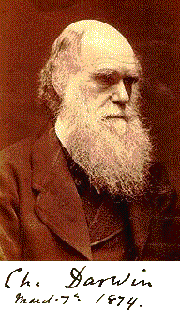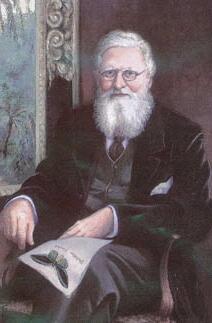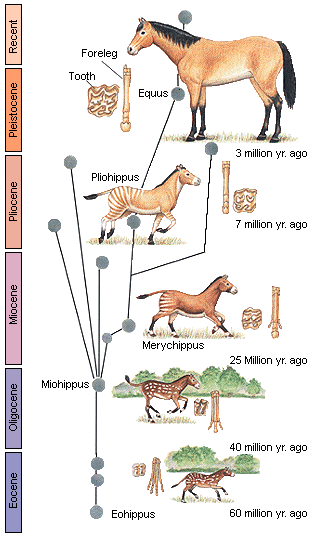|
Fossil Horses: Systematics, Paleobiology and Evolution of the Family Equidae, by Bruce J. MacFadden (Cambridge University Press, 1992) is more than just a book about fossil horses. It is a book about evolution, with all of the major facets of evolutionary biology illustrated by examples taken from the fossil record of horses. The chapter titles are:
1. Introduction: Why study fossil horses?
2. A renaissance in paleontology
3. Orthogenesis and scientific thought: old notions die hard
4. Collections, musuems, and exceptional discoveries
5. Systematics and phylogeny: Ungulata, Perissodactyla and Equidae
6. Isotopes, magnetic reversals, fossils, and geological time
7. Ancient geography, changing climates, dispersal, and vicariance
8. Evolutionary processes: variation, speciation, and extinction
9. Rates of morphological and taxonomic evolution
10. Trends, laws, directions, and progress in evolution
11. What's the use? Functional morphology of feeding and locomotion
12. Population dynamics, behavioral ecology, and 'paleoethology'
13. Fifty-eight million years of community evolution
14. Epilogue
|
|
The artwork depicting horse evolution is from Professor Donald Levin's course in BioEvolution at the University of Texas in Austin. This is a brief, highly illustrated course with many examples given of macroevolution. Notice that the generalized branching diagram in this illustration is less twiggy than the more bushy branching depicted at other resources mentioned here.
|
Fossil Horses at the Florida Museum of Natural history has an excellent exhibit showing the evolution of horses and their leg/foot bones. Click on the fossil horse gallery, which shows the evolutionary branching in horses with brief, nicely illustrated pages for 15 major groups, linked to biostratigraphic levels.
Horse Evolution is Kathleen Hunt's FAQ at www.talkorigins.org. Horse species did not always come into being by gradual transformation (anagenesis) of their ancestors; instead, sometimes new species split off from ancestors (cladogenesis) and then co-existed with those ancestors for some time. Described are about 30 genera of horses during 55 million years of evolution. Notice the extensive branching patterns.
Is "Dawn Horse" a Hyrax? Creationists claim that Hyracotherium is nothing more than a Hyrax. This excellent essay from Talk Origins dispells that myth.
Evidence for Horse Evolution : Discusses the ups and downs of horse evolution. A chart shows the general trend in equid body size over millions of years. While such trends as toe reduction and increase in size are real over time, the rate of change varied among different branches of the equid evolutionary bush, and there were reversals along the way. The evolution of horses was not a steady ladder of progress.
|
|
|
Evolution of the Horse : Deb Bennett's page includes detailed information regarding Structural Adaptations, Dental Evolution, Skull Evolution, Axial Skeletal Evolution and Apendicular Skeletal Evolution. A cladogram is keyed to important steps in the evolution of this lineage.
Horses, Simpson, and Orthogenesis : Just in case you encounter this out of context quote of George Gaylord Simpson regarding horse evolution.
|
|
Did Hyracotherium and Equus live at the same time, as Creationists have claimed?
Josephy Leidy, the Academy of Natural Sciences and American Fossil Horses
Thomas Jefferson, the ANSP and Fossil Horses Thomas Jefferson Fossil Collection.
Thomas Jefferson is rightly famous as the author of the Declaration of Independence and as the third president of the United States. But he was also a highly respected scholar and avid naturalist who promoted and supported paleontological studies in the earliest years of the republic.
This Online Exhibit is currently being reformatted and will become available later during the Fall of 2025.
|
|
Fossil Horses: Systematics, Paleobiology and Evolution of the Family Equidae, by Bruce J. MacFadden (Cambridge University Press, 1992)
The Evolution of Perissodactyls, edited by Donald R. Prothero and Robert M. Schoch (1989, Clarendon Press/Oxford University Press)
Horses: The Story of the Horse Family in the Modern World and through 60 Million Years of History, by George Gaylord Simpson (1951, Oxford University Press). Although woefully outdated, this is still a classic referrence.
The Ascent of Equus: The Story of the Origin and Development of the Horse, by Chester Stock and Hildegarde Howard (1963, Los Angeles County Museum Science ServiceSeries No, 22). This hard to find publication is of historical interest in documenting the changing ideas about the nature of evolution in general and the evolution of the horse in particular.
Horses and History - The story of the horse from earliest times:his place in war, peace and sport; and his claims to a lasting position as man's ally, by George Gaylord Simpson (1936, Natural History, Volume 38(4):277-288)
Studies on the taxonomy and phylogeny of the genus Equus: 1. Subgeneric classification of the recent species, by Colin P. Groves and David P. Willoughby (1981, Mammalia, Volume 45 (1):321-354)
Stripes do not a Zebra make, Part 1: A Cladistic Analysis of Equus, by Debra K. Bennett (1980, Systematic Zoology, Volume 29(3):272-287)
Taxonomic evolution in North American Neogene horses (subfamily Equinae): the rise and fall of an adaptive radiation, by Richard C. Hulbert, Jr. (1993, Paleontology, Volume 19(2):216-234)
Evolution, Systematics and Phylogeography of Plesitocene Horses in the New World: A Molecular Perspective, by Jaco Weinstock et al. (2005, PLoS Biology Volume3(8): 7 pages) pdf file
|


